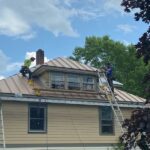Cold Weather
FACT
Buildings in areas subject to cold weather present certain challenges to roofing.
ANALYSIS
One of the primary challenges to roofing presented by cold weather is the ability of actually trying to roof the building in cold weather. Next, cold weather brings ice, snow, and energy efficiency issues, all of which affect the roof.
SOLUTION
Metal roofing, unlike standard shingles, does not need a “seal-down” period of warm temperatures for proper curing. Therefore, as long as the installers can safely access the roof, they can work with metal. The minimal expansion and contraction that occurs with metal roofing does not affect the material’s ability to be installed in cold weather. While some sealants are used with metal roofing (see Technical Bulletin #9), there are durable sealants available that can be used at low temperatures and even in moist conditions. Metal roofing, as it ages, is also quite unaffected by cold weather. Unlike porous roofing materials, it does not absorb moisture and then be affected by freeze-thaw cycles. These freeze-thaw cycles are a major contributor to the degradation of tile, wood, and standard shingle roofs. Additionally, metal roofing is known for its ability to shed ice and snow and it is one of the most resistant materials when it comes to ice dams (see Technical Bulletin #12).

